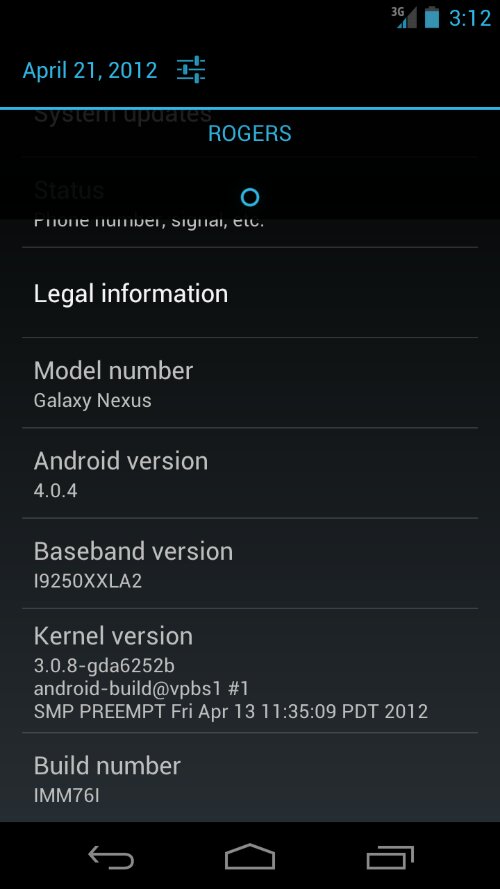Finally!!! I have finally updated my old guide and edited it to now make a new guide on how to update your ‘Yakjuux’ build Galaxy Nexus to the new ‘Yakju’ build running the latest version of Android, Jelly Bean 4.1.1. I have left the old guide up for those who want to be able to get the update OTA from Google, but if you choose to bypass the OTA and go straight to the latest version, this is the guide for you. I have left all the old information regarding what the ‘Yakjuux’ and ‘Yakju’ builds are for new users who may not have seen the old post so skip down to the bottom for the instructions. I will also be adding a FAQ section soon as I have received many of the same questions and will save you some time even though most of the questions are answered in this post.
So you’ve purchased a new Galaxy Nexus phone from Rogers, Telus, Fido, Bell, AT&T or any other GSM with hopes of having the latest updated; it turns out that there are two different builds, ‘yakjuux’ and ‘yakju’. The main differences between these two builds is that the ‘yakjuux’ build is pushed out by Samsung and the Yakju build is pushed directly from Google. The benefit from having the ‘yakju’ build is that you will receive the updates much faster as they are being pushed from Google directly.
The current pushed versions of Ice Cream Sandwich:
YAKJUUX – 4.0.2
YAKJU – 4.1.1 (JRO03C)
In this tutorial, I am going to show you how to update your build from the ‘yakjuux’ to ‘yakju’ build of Jelly Bean 4.1.1 on Mac OS X. I am using OS X lion 10.7.3.
Disclaimer: I take no responsibility for any damages you incur to your phone by updating. I am merely writing a how-to guide and everything is done at your own risk.
Make sure you backup anything on your phone as this process will wipe everything.
First you will need to download the fastboot file which is located inside the ‘Nexus’ folder. That file can be downloaded https://www.dropbox.com/s/lkaey1tajd0ttnx/Nexus.zip
You will want to place the Nexus folder onto the desktop as the commands below require it.
Inside the “Nexus” folder, you will find the file “fastboot”. Open this up the way you would an application and let is run. It will ‘install’ whats needed. If you don’t, you will receive a permission denied reply when you try to run the fast boot commands.
Next, download the Factory Image for Android 4.1.1 here: Link
You will want to download UnRarX in order to extract the Android 4.1.1 tgz file. Once you are ready to extract the file, extract the contents to the ‘Nexus’ folder located on the desktop.
Next download the Android File Transfer software for mac from http://www.android.com/filetransfer/ and install.
At this point, you should have everything extracted into the ‘Nexus’ folder on the Desktop and we are ready to start the process.
We are going to start by unlocking the boot loader. This is needed so that we can install the ‘yakju’ image files. Note: This is not the same thing as rooting your phone.
First you are going to want to plug-in your Nexus and make sure that the Android File transfer recognizes the phone. If it does, power down the phone with it still being connected to the computer.
Next, boot the phone into recovery mode. To do this, power down the phone and restart it by holding the power and volume up/down buttons until you see the recovery screen.
Next, we will unlock the Bootloader. To do this, open up Terminal(located in your Applications->Utilities folder)and type the following commands.
1.) cd ~/desktop/Nexus (hit enter after typing each one if these commands)
2.) ./fastboot devices
If everything is installed correctly, you should see xxxxxxxxxx fastboot(the numbers represent your serial number)
3.) ./fastboot oem unlock
4.)Your phone will ask you if you want to unlock the bootloader. Use the volume up button to ‘yes’ and select it by pressing the power button.
NOTE: THIS WILL ERASE ALL DATA ON YOUR PHONE. Your bootloader is now unlocked.
Next we will install the new files:
5.)type ./fastboot flash bootloader bootloader-maguro-primelc03.img
6.) type ./fastboot reboot-bootloader
7.) type ./fastboot flash radio radio-maguro-i9250xxlf1.img
8.) type ./fastboot reboot-bootloader
9.) type ./fastboot -w update image-yakju-jro03c.zip
At this point, the phone will automatically restart. Once the phone has booted to the factory startup screen, power down again and and boot into recovery mode.
We are going to now re-lock the bootloader. Keep in mind that if you choose to lock it and want to update to a future version, you will need to re-unlock it and thus erase everything again. If you decide that you need to send it in for warranty, you will want to re-lock it.
To lock the bootloader:
In the Terminal, type the following:
1.) type ./fastboot devices
2.) type ./fastboot oem lock
Your bootloader is now locked again.
3.) ./fastboot reboot
Your phone is now updated to the latest firmware, Android 4.1.1 Jelly Bean. As well, you will now also be able to receive the future OTA updates directly from Google.









